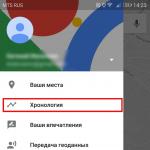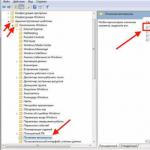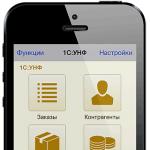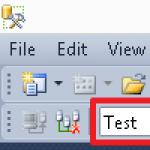And it is a clickable ball containing the Windows logo. If you click on the ball, we will be presented with a set of recently launched programs and a list of the most necessary elements. To make your PC unique and personalized, check out: how to change the start button in Windows 7 all editions(Maximum, Home Basic, etc.), in this manual.
With , in most cases, “start” remains unchanged, since it is tied to Explorer (explorer.exe). To fit it into the current design, use programs and pens to change the appearance.
Changing the start button through the Windows 7 StartOrbChanger (W7SOC) program
Free program W7SOC, which can change the start button on Windows 7 with a couple of mouse clicks. W7SOC has a simple interface and is easy to operate. She works:
- With all DPIs (if the image is too large or small, the utility itself resizes it).
- With X86/32 bit and X64/64 bit OS versions.
- With PNG and BMP graphic formats.
To change the Start icon in Windows 7, complete the following tasks:
1. Download the program and extract it from the archive.
2. Right-click on w7soc.exe and enable it as administrator.
3. The main window's interface couldn't be simpler. The top part shows the 3 states of the start button: default, hover and pressed.
After the states there are 2 buttons:
- Change – helps you specify the path to PNG and BMP and changes the start button.
- Restore – resets changes and restores the default icon.
To expand the settings, there is an arrow at the bottom right.

4. Click on the arrow and you will see an additional menu. See the description below the numbers in the picture. The menu has the following items:
- Changing the start button by making changes to the .
- Changing the start icon by replacing the original file %WINDIR%\explorer.exe.
- Adds a "Start Orb" shortcut to the desktop right-click context menu. This way you can quickly turn on W7SOC.
- Adds a "Set As Start Orb" option to the menu when right-clicking PNG and BMP files. When you select this weaving, the appearance of the start button instantly changes.
- Disables the message about a successful change.
- When you start the utility, it always displays the extended menu.
- Shows the process running in cmd. , a cycle is made and after pressing any key, the start changes and acquires a new icon.

5. Customize W7SOC for yourself and click “Change” and specify the path to the icons. There are already 11 different buttons in the “start buttons” folder, select any one and click “open”. You can also download it from the network or draw it yourself.

Explorer will restart and the start button will change the icon to the selected one. If you want to return the previous icon, then click “Restore”.
Important! If the taskbar and desktop have disappeared, click File - New Task and type explorer.exe in the line and click Enter. If nothing works, then in cmd enter the command to restore system files SFC / SCANNOW, press Enter and wait until the procedure completes.
Change with the Windows 7 Start Button Changer (W7SBC) program
You can change the Start menu icon using another utility called W7SBC. Worse than the first option, but the result is similar. It is advisable to create a system restore point, or skip this step and use the restore command in case of damage to system files.
1. Download the utility and extract the archive.
2. Run Windows 7 SBC.exe from the W7SBC folder as an administrator. Do not change the folder name; this action may cause problems.

3. On the left in the main window the current launch design will be displayed. Using 1 line, it becomes possible to change the start button in Windows 7. The line below restores the default icon. Click on line 1 with the rounded logo.

4. Specify the path to the downloaded or ready (folder 10 Sample Orbs) bmp file. Click "open". Wait until the explorer restarts and see the result.

If you want to return the “start”, then click on the Explorer icon to restore the original files. Wait for the explorer to reboot, then if everything goes well, you will see a sign like this.

If you need to change the start button again, first restore the original, and then install a new icon.
If you have gone through the steps and the start has not changed, do this:
- Close the program.
- Manually take over the path C:\Windows\explorer.exe.
- Run the program, repeat the steps.
Change the start button in Windows 7 It won't be too stressful. For harmony, so that they fit completely. Of the 2 programs, preference is given to W7SOC; it has a number of flexible settings that expand functionality.
While thinking about which PC problem to devote this article to, I remembered one fascinating incident. An acquaintance once called me and, with a voice trembling with fear, reported that after turning on and booting his PC, he found absolutely nothing on the desktop: neither the taskbar with the Start button, nor the desktop icons. Nothing but a background image. Rebooting and running in safe mode did absolutely nothing. Additionally, right-clicking on the same desktop didn't work either.
At first glance, this problem looks insoluble and terrifying. However, since I had encountered this kind of problem before, solving it this time did not require tectonic efforts. And the solution is this:
The explorer.exe process is responsible for the visual display of everything that is missing in our case. In our case, in the task manager in the “Processes” tab, explorer.exe was completely absent.

To successfully resolve this system failure, you must first determine whether the explorer.exe file itself is present in the system or whether it has been deleted for some reason. This will allow us to decide on further steps to eliminate this problem.
To do this, press the treasured Ctrl + Alt + Del, thereby calling up the task manager. Now in the “File” menu select “New task”.

In the window that opens, enter “cmd” and press Enter.

cd C:\Windows
(where “C” is the drive label of Windows OS).
explorer.exe

If after entering this command the panel and icons appeared, or nothing happened at all, then the explorer.exe file is intact, and we simply need to fix some registry files.
If, after entering the above command, the system displays an error message, you will need to copy this same explorer.exe file from the installation disk with the OS and place it in the Windows folder. We will consider the first option, since it is the one that most often causes the entire contents of the desktop to disappear.
Press Ctrl + Alt + Del again and again select “New task” from the “File” menu. In the input field we write “regedit” and press the Enter key.

The registry editor appears before us. And here you need to perform 2 steps.
1) On the left side of this editor, you should step by step open the following address:
HKEY_LOCAL_MACHINE\SOFTWARE\Microsoft\Windows NT\CurrentVersion\Winlogon

After that, pay attention to the right side of the editor. There is a Shell parameter here and it should be Explorer.exe. If its value differs from this, then change it to Explorer.exe.

Hello!
Every computer user (especially the female half :)) tries to give their Windows originality and customize it for themselves. It's no secret that not everyone likes the basic settings, and besides, they can even slow down your PC if it is not particularly powerful (by the way, such effects include the same Aero).
Other users want to disable various graphical bells and whistles, because... we’re simply not used to them (after all, all this didn’t exist in Windows 2000 and XP before. I, for example, am generally quite ascetic about this, but I have to help other users...).
So, let's try to change the appearance of the seven a little...
How to change the theme?
Where can you find a lot of new topics? At the office Microsoft website has a sea of them: https://support.microsoft.com/ru-ru/help/13768/windows-desktop-themes
Theme - in Windows 7, the theme refers to everything that you see. For example, the picture on the desktop, window color, font size, mouse cursor, sounds, etc. In general, all display and audio are related to the selected topic. A lot depends on it, which is why we’ll start setting up our OS with it.
In order to change the theme in Windows 7 you need to go to personalization settings. To do this, it is not necessary to go to the control panel; you can simply right-click anywhere on the desktop and select “personalization” from the menu (see Fig. 1).
There are quite a lot of other topics on the Internet, just above under the title of this subsection of the article I provided a link to the office. Microsoft website.
By the way, an important point! Some themes may even cause your computer to slow down. For example, themes without the Aero effect (which I talked about here:) run faster (usually) and require lower computer performance.
How to change the background, wallpaper on your desktop?
Large selection of ready-made wallpapers: https://support.microsoft.com/en-us/help/17780/featured-wallpapers
The background (or wallpaper) is what you see on your desktop, i.e. background picture. This picture has a very big influence on the design. For example, even the taskbar bar changes its color depending on what picture was selected for the wallpaper.
To change the standard background, go to personalization (note: right click on the desktop, see above), then at the very bottom there will be a link “” - click it (see Fig. 3)!
By the way, the background on the desktop may be displayed differently, for example, there may be black stripes along the edges. This happens because your screen has a resolution (more about this here -). Those. roughly speaking, a certain size in pixels. When it doesn't match, then these black stripes are formed.
But Windows 7 may try to stretch the picture to fit your screen (see Fig. 4 - the lowest red arrow: “Fill”). True, in this case, the picture may lose its entertainment value...
How to change the size of icons on the Desktop?
Change icon size- very simple! To do this, right-click anywhere on the desktop, then select the “view” menu, then select from the list: large, medium, small (see Fig. 5).
How to change the sound design?
To do this you need to open in control panels Personalization tab, and then select Sounds.
Here you can change the usual soundtrack to various others: landscape, festival, heritage, or turn it off altogether.
How to change the screensaver?
We also go to the personalization tab (note: right-click anywhere on the desktop), select the screensaver item below.
How to change screen resolution?
Option #1
Sometimes you need to change screen resolutions, for example, if the game slows down and you need to launch it with lower parameters; or check the operation of a program, etc. To do this, right-click on the desktop, and then select screen resolution from the pop-up menu.
Option No. 2
Another way to change the screen resolution is to configure it in video drivers (AMD, Nvidia, IntelHD - all manufacturers support this option). Below, I will show how this is done in ItelHD drivers.
First you need to right-click on the desktop and select “Graphic characteristics” in the pop-up menu (see Fig. 12). You can also find the video driver icon and go to its settings in the tray, next to the clock.
Rice. 12. Graphic characteristics
Rice. 13. Resolution, display section
How to change and customize the START menu?
To customize the START menu and taskbar, right-click on the "START" button in the lower left corner of the screen, then select the properties tab. You will be taken to the settings: in the first tab you can configure the taskbar, in the second - START.
It probably doesn’t make much sense to describe every checkbox in the settings. It’s best to set it up experimentally: if you don’t know what the checkbox means, turn it on and see the result (then change again - look, at random you will find what you need :))..
Setting up showing hidden files and folders
Here, it is best to enable the display of hidden files and folders in Explorer (many beginners get lost and don’t know how to do this), as well as showing file extensions of any file types (this will help avoid some types of viruses that disguise themselves as other types of files).
This will also allow you to know for sure what kind of file you want to open, and also save time when searching for some folders (some of which are hidden).
To enable display, go to control Panel, then to the tab design and personalization. Next, look for the link “ Show hidden files and folders"(in the Explorer settings section) - open it (Fig. 17).
- uncheck the box next to “ hide extensions for registered file types«;
- move the slider to “show hidden files, folders and drives” (see Fig. 18).
Desktop gadgets
Gadgets are small information windows on the desktop. They can notify you about the weather, about incoming email messages, show the time/date, exchange rates, various puzzles, slides, CPU load indicators, etc.
You can use the gadgets installed in the system: go to control Panel, enter “gadgets” into the search, then you just have to choose the one you like.
By the way, if the presented gadgets are not enough, then you can additionally download them on the Internet - there is even a special link for this under the list of gadgets (see Fig. 19).
Important note! A large number of active gadgets in the system can cause a decrease in computer performance, slowdowns and other delights. Remember that everything is good in moderation and do not clutter your desktop with unnecessary and unnecessary gadgets.
That's all for me. Good luck to everyone and bye!
In Windows, you can change the design, themes, desktop background, screensavers and shortcuts. But you cannot change the design of the Start button through standard settings. It displays the Win logo by default. And what if you want to see a different image on the main menu? The only option is to use third-party programs, since the OS itself does not provide the necessary tools. Find out how to change the Start button in Windows 7, what utilities are suitable for this, and how to use them.
The main menu picture is tied to the “Explorer.exe” system service (do not confuse it with the name of the browser). The new icon should not affect the operation of Win. But still this is a change in OS files. And it’s better to create a restore point. If something goes wrong, you can return the settings that were before installing the icon.
- Click the Start button.
- Go to "Control Panel".
- "System" menu in the "System and Personalization" category.
- Item "Additional parameters". He's on the right.
- System Protection tab.
- "Create" button.

Click on Create
- Come up with a name for the restore point.
- Wait while the current Windows configuration is saved. You can return to it in the future if critical errors occur.
- To make a backup, click the “Restore” button. It's in the "System Protection" menu. All available points will be there.
Administrator rights
To change the main menu icon, you need full access to Explorer.exe. This is the service responsible for the conductor. The file is located in the system root directory C:/Windows/. To edit it you need administrator rights.
- Go to this folder.
- Find "Explorer" and right-click on it.
- “Properties” item.
- Section "Security".
- Click the "Edit" button.

- In the “Permissions for the System group” field, set the value to “Full Control”.
- Click on "Apply".
You can also open administrative access to the file using the Takeownershipex program. Find it online, download, install and run. There will be two buttons: “Gain access” and “Restore access”. Click on the first one and specify the path to “Explorer”.
Just in case, create a backup copy of this file. Just copy it anywhere. If anything, you can change the edited version to the original one.
Where can I find the badges?
It’s better not to put the first art you like from your gallery on the “Start” button. Use images specifically designed for this purpose. They are already edited and have the appropriate format and size. They also specify the correct arrangement of objects. Suitable images can be downloaded from the 7themes website or oformlenie-windows.ru. Although there are a lot of resources with free icons.

Possible appearance of the Start button
The file with the icon must have a BMP extension (no background). Make sure that it has three options for icons: for a “regular” button, highlighted and pressed. Try hovering over the main menu. And you will see that it changes depending on what is done with it. Although no one forbids putting one picture for all “states”.
Start Button Changer is a utility through which you can load a new image for the main menu. It has a very simple interface. There are only two functions: setting an icon and resetting to original settings. Suitable for Win 7 only. The name of the program translates something like this: “Start Button Converter.” Here's how to use it:
- Find it on the Internet and download it. Just enter the query “Windows 7 Start Button Changer” in a search engine and select any site. It is better to download from resources that are on the first page in the search results.
- If the utility is in an archive, unpack it.
- There should be an executable file with the extension .EXE.
- Right-click on it.
- “On behalf of the administrator” item.

Start Button Changer window
- To change icons, click the “Select & Change” button.
- Specify the path to the icons.
- Click on “Open”.
- To restore the original settings, there is the “Restore Original” option.
Start Orb Changer for Windows 7
Here's how to change the Start icon on Windows 7 using Start Orb Changer
- Find it online and download it.
- Unpack it if it is in the archive.
- Run it as administrator.

- There will be three samples of icons: “Default” (not active), “Hover” (when selected - you need to move the cursor) and “Pressed” (pressed).
- To change them, click on “Change”.
- Specify the path to the graphic file.
- The “Restore” button resets the settings and returns the standard icon.
The application has advanced options. To open them, click on the small gray arrow at the bottom right. Only two points are important.
- By Patching Memory. RAM is used to change the main menu.
- Be Editing Resources. Edited by "Eexe".
Classic Shell
The Classic Shell utility is suitable for Windows 8 and 10. It is a comprehensive program for customizing the Start menu. But now we only need icons in it.
- Download it from classicshell.net. There is a tab “ALL DOWNLOADS”.
- Start the installation. To work with the design of the main menu, use the “Classic Shell Start Menu” component. You don't have to download the rest.

- Open the application.
- On the Menu Style tab, select the All Options option and click OK.
- You want classic Win style
- Check the “Change button image” checkbox.
- Check the "Other" box.
- "Select image."
- Show the way to it.
If “Start” is missing
If after installing the icon the menu bar and all shortcuts on the desktop disappear, you need to restart Explorer.
- Launch Task Manager. To do this, use the Ctrl+Shift+Esc keys.
- Go to File - New Task.
- In the input field that opens, write “explorer.exe” without quotes.
- Click OK.
The Start button cannot be changed through personalization settings. Yes, and in other Win parameters there is no such option. To add a new icon, you need third-party programs. They edit the system file “Explorer.exe”, to which the icons are attached.
Windows 8 is a rather different system from previous versions. Initially, it was positioned by the developers as a system for touch and mobile devices. Therefore, many things that are familiar to us have been changed. For example, a convenient menu "Start" you won’t find it anymore, because they decided to completely replace it with a pop-up sidebar Charms. And yet, we will look at how to return the button "Start", which is so lacking in this OS.
You can return this button in several ways: using additional software or only system tools. Let us warn you in advance that you will not return the button using the system, but simply replace it with a completely different utility that has similar functions. As for additional programs - yes, they will return to you "Start" exactly as he was.
Method 1: Classic Shell
With this program you can return the button "Start" and completely customize this menu: both appearance and functionality. So, for example, you can put "Start" with Windows 7 or Windows XP, or simply select the classic menu. As for the functionality, you can reassign the Win key, specify what action will be performed when you right-click on the icon "Start" and much more.

Method 2: Power 8
Another fairly popular program in this category is Power 8. With its help you will also get back a convenient menu "Start", but in a slightly different form. The developers of this software do not return the button from previous versions of Windows, but offer their own, made specifically for the eight. Power 8 has one interesting feature - in the field "Search" you can search not only on local drives, but also on the Internet - just add a letter "g" before requesting to contact Google.

Method 3: Win8StartButton
And the last software on our list is Win8StartButton. This program is created for those who like the general style of Windows 8, but still feel uncomfortable without menus "Start" on the desktop. By installing this product, you will receive the necessary button, when you click on it, part of the elements of the eight start menu appears. It looks quite unusual, but it fully corresponds to the design of the operating system.

Method 4: System Tools
Also you can make a menu "Start"(or rather, its replacement) with standard system tools. This is less convenient than using additional software, but still this method is also worth paying attention to.

We looked at 4 ways in which you can use the button "Start" and in Windows 8. We hope we were able to help you and you learned something new and useful.




